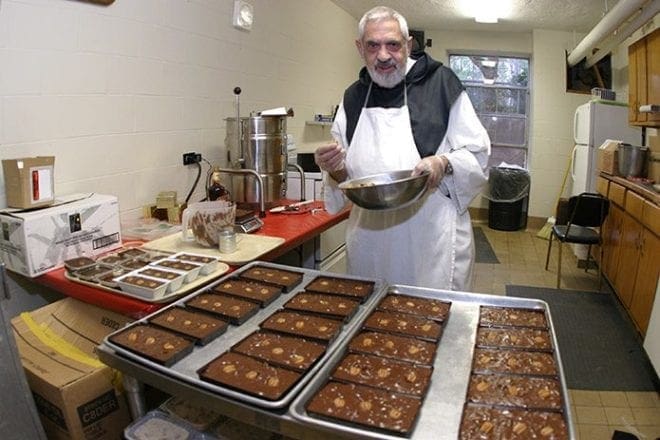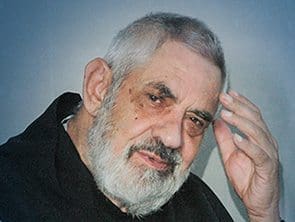 Photo Courtesy of the Monastery of the Holy Spirit/Stephen Golder
Photo Courtesy of the Monastery of the Holy Spirit/Stephen GolderConyers
Father Anthony Delisi, ‘the one who invited people in,’ is laid to rest
By GRETCHEN KEISER, Staff Writer | Published May 26, 2016
CONYERS—Father Anthony Delisi, 87, a Cistercian monk for 67 years and priest for 61 years, was buried in the monks cemetery alongside Our Lady of the Holy Spirit Abbey on Saturday, May 14, following a Mass of Christian Burial attended by hundreds of people whose lives he had touched.
Because the portion of his monastic life lived in Nigeria was very special to Father Anthony, a carved horn was blown to begin the Mass and Nigerian songs of prayer and praise were sung as he was being placed in the earth at the burial.
A descendant of Sicilian people, a gardener and builder, plainspoken, and, later in life, a writer on prayer, he was many things to many people, the abbot, Dom Francis Michael Stiteler said.
‘An unusually large group of friends’
“I think maybe ‘mystery’ for me provides the word for Father Anthony,” the abbot said. “I think that is what you get when you deal with holy men and mystics. You don’t always get what you expect. He had many sides to him, many passions, strong passions.”
“Our Father Anthony, a cloistered monk, had an unusually large group of friends, many of whom were invited to feel especially close to him,” he said.
“I think he had a real gift to make folks feel special, and yet at the same time, he didn’t just have a few special friends. He had many special friends, very strong commitments and bonds to them.”
Born in 1928 in western Pennsylvania, he entered the Conyers monastery in 1948, just four years after it was founded. He made his solemn profession of vows in 1953 and was ordained a priest in 1954. The six-plus decades of his monastic life included all seven abbots in the community’s history.
He was almoner, helping to reach out to the poor in the community, which evolved into the monastery food bank. He taught classes to the monks in Church history, Scripture, liturgy and monastic history. He helped Cistercian monks in Nigeria and then was chaplain to nuns there and oversaw construction of their chapel, a period lasting from 1979 to 1987. He was retreat master in the Conyers monastery for 15 years after coming back from Africa and in 2002 was asked to serve as temporary superior of the monastery. He wrote on prayer. Over the years he found hundreds of Indian arrowheads on the grounds of the monastery, which are in a collection there. He created knotted rosaries and a monastery recipe for Southern fudge. He lately was the official greeter at the visitors center, answering questions, blessing rosaries and religious articles and hearing confessions, too.
Because of his study at the University of Notre Dame, he is considered a key person who brought the Catholic charismatic renewal movement to the Atlanta Archdiocese in the 1970s. In 1987 he was one of the monks chosen to help lay people seeking better faith formation and spiritual direction, the beginning of the now well-established Lay Cistercian community.
“As we know, he was a strong and passionate person, from the Deep South,” the abbot said. “Not Mississippi—Sicily.”
Gardener of plants and people
“I worked under him in the garden for many years. He was a tough taskmaster. We supplied food to the farmers market in Atlanta. And if he had an order, it was to be fulfilled. I can tell you on more than one occasion I was out in pouring rain in 38 degree temperatures, picking kale and collard greens to get to Atlanta,” Abbot Francis Michael said.
“When I was asked to be novice master, which I was for seven years, I immediately asked him to be my assistant because I knew he had a different spirituality and a different outlook and that those who might not be able to tie into me might be ministered to by him,” the abbot said.
An avid reader of fiction, the abbot once asked Father Anthony if he had ever read a novel. “He didn’t miss a beat. He said, no, why would I? It’s not true.” A bit stunned, the abbot said he stayed silent, knowing better than to argue with his Sicilian monastic brother.
“Even though I had my differences with him, he was somebody who I from the beginning deeply reverenced and honored and loved,” Abbot Francis Michael said.
The congregation at the Mass was the largest the abbot said he had seen at a monk’s funeral.
Drawn to the Nigerian community
Gloria Chukwuma of the Nigerian Igbo Catholic community, said to them Father Anthony was known as Father Udochukwu, which means “peace of God.”
“He was a very devout man. He has given Legion of Mary retreats and talks on the Blessed Mother. Because of his devotion to Our Lady, he was a dear friend of the Legion of Mary in the archdiocese.”
“He was very dear to us,” she said. “He was always very available. You can stop him, talk to him, go to confession. He even came one time and gave a talk to the Nigerian Catholic community at St. Anthony’s.”
He shared their dedication to seeking sainthood for Blessed Father Cyprian Tansi, a Nigerian Cistercian monk who was beatified in 1998 by St. Pope John Paul II.
Asked why Father Anthony had such a strong fellowship with Nigerian Catholics, she said, “He said the faith of the people captivated him. When he came back (to Georgia) he still longed to be with them. That was what continually drew him to the Nigerian community. We were told he wanted Igbo songs at his funeral.”
About 20 members of the Nigerian Igbo Catholic community sang and played percussion instruments and beaded gourds. Dr. Ifeanyi J. Anikpe blew the horn he had carved himself.
He was bedrock for Lay Cistercian community
Lay Cistercians meet at the monastery one Sunday a month for teachings, peer group ministry and Mass. Father Anthony, despite failing health, continued to come and celebrate Mass for them and teach on the Rule of St. Benedict. Recently he was in a wheelchair and could not stand for the entire Mass, but “he was determined to be there,” said Frank Mulcahy, a Lay Cistercian.
“He was a very dedicated monk, but his ministry reached out so far, way beyond the cloister,” said Father John Kieran, who served as pastor in Conyers for many years. “He was a man that connected his spirituality with so many lay people.”
Dewey Kramer, who co-authored an oral history of the monastery, said Father Anthony was the one who first allowed lay people to be seated inside the abbey church itself for prayer and Mass, rather than being separated from the monastic community by a partition. “He is the one who invited people in,” she said.

Eighty-seven-year-old Pennsylvania native and Trappist Father Anthony Delisi died May 9. Father Delisi arrived at the Monastery of the Holy Spirit, Conyers, in 1948. He held a number of roles, including gardener, historian, liturgist and writer; moreover, for many years he was a fixture in the monastery bakery. In this 2004 photograph he is standing over completed trays of fudge ready for packaging. Photo by Michael Alexander
Darice Gamble, of St. Paul of the Cross Church, Atlanta, said she was thinking about how he spoke in a down-to-earth way and, in fact, didn’t talk a lot. “When he would speak, they were words of wisdom,” she said.
She came to see him once and at the time was very active in the Catholic charismatic renewal. “He said, the Lord is ready to quiet you down now,” Gamble said. He advised her to consider becoming a Lay Cistercian, which she did, completing five years of formation and professing lifetime promises. She was able to see him in the infirmary May 6. He died there on May 9.
“I am learning, and I am going to dwell on his tremendous wisdom with respect to my own life and just remember the importance of humility, obedience and the importance of stillness—being quiet,” Gamble said.
Eager to know how people find God
Jackie Rychlicki is one of five people considered founders of the Lay Cistercians of Our Lady of the Holy Spirit in 1987. They were placed under the direction of Father Anthony and Dom Augustine Moore. Father Anthony was also her confessor. She said his zeal took her way out of her comfort zone and brought growth and awareness of the Lay Cistercians across the order worldwide.
In Conyers they have professed about 100 people over the years with about 45 coming to monthly formation. They are part of a worldwide expression, as there are Lay Cistercians in English-, French- and Spanish-speaking countries.
The initial seed “would not have had the opportunity for life if he had not had the personality and the spiritual gifts to make it known within the order how well it was working in the monastery for the benefit of sincere lay people and at no detriment to the monastery,” she said.
At the beginning, Father Anthony took a sheet of paper on which she had jotted down a one-page rule of life and came back with it typed up, asking her, “Is this what you’re talking about?”
“He could seem to people to be an abrupt shell (but) with the tenderest heart inside of it,” she said.
“He eagerly wanted to know what it was like to be a human being. He liked tribal Nigeria. He liked families with little children. He liked milkshakes and chocolate.”
He was able to minister “to people of all ages, personalities and nationalities because from the beginning he was interested in what it means to be a human being and how human beings find God.”
“He was a person in bold font, nothing wishy-washy,” Rychlicki said.
“I liked it when I would see him sitting in a chair alongside the Blessed Sacrament and he would write on the backs of envelopes and they became the ‘Waiting’ books … the Anthony that had stillness inside of him. Outside of my parents and my husband, I don’t think anyone molded my life more than Father Anthony,” she said.
“He set out a path that I was afraid to walk. He sometimes would take me by the hand and lead me and other times would push me out the door.”
When they brought his body into the church for the overnight vigil on May 13, the monks invited four Lay Cistercians to be among the eight pallbearers, including Rychlicki. This was “as precious a memory for me as any of the things he ever said or did.”
Concluding his words at the Mass the next day, Abbot Francis Michael said, “He is not gone. As Christians we believe he has gone ahead of us, which is a very different meaning … to the fuller presence of the God of the living. … Know that we continue to be bound to him in Christ, even more closely now in the mystery of the Trinity, where all of us move and live and have our being.”
Memorial contributions and messages of condolence may be sent to Abbot Francis Michael Stiteler, OCSO, Monastery of the Holy Spirit, 2625 Highway 212, SW, Conyers, GA 30094. More remembrances may be found at www.trappist.net.


